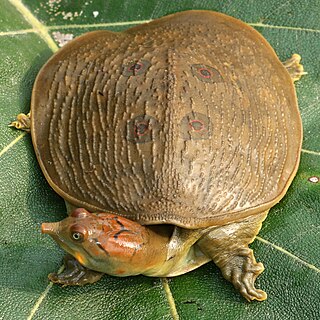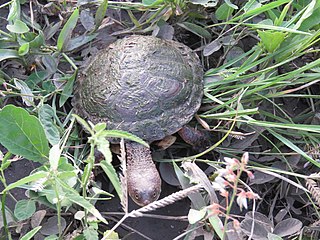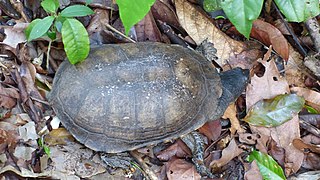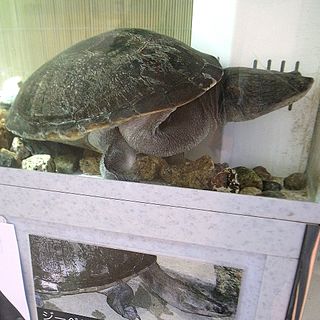
The eastern long-necked turtle is an east Australian species of snake-necked turtle that inhabits a wide variety of water bodies and is an opportunistic feeder. It is a side-necked turtle (Pleurodira), meaning that it bends its head sideways into its shell rather than pulling it directly back.

Chersobius signatus is the world's smallest species of tortoise. The species is commonly known as the speckled tortoise and also known locally as the speckled padloper and internationally as the speckled Cape tortoise. A member of the genus Chersobius, it is endemic to South Africa.

Leith's softshell turtle is a species of turtle in the family Trionychidae. The species is found in peninsular Indian rivers including the Thungabhadra, Ghataprabha, Bhavani, Godavari, Kaveri and Moyar Rivers. The type locality is Pune in India.

Macrochelys is a genus of very large freshwater turtles in the family Chelydridae, native to the Southeastern and Midwestern United States. Only a single extant species was recognized until 2014, when a study divided it into two, or possibly three species. These turtles are easily recognized by three distinct dorsal ridges with raised spikes.

Sternotherus is a genus of turtles in the family Kinosternidae including six species commonly known as musk turtles. The genus is endemic to North America, occurring in the eastern third of the US and southeast Ontario, Canada. Musk glands positioned near the bridge of the shell can produce foul smelling secretions when the turtles are threatened, although gentle handling does not normally provoke a response. Sternotherus are moderately small turtles, with the largest species in the genus, the razor-backed musk turtle, attaining a maximum of 17.6 cm. in shell length. The carapace is characteristically oval and domed, with most species having one or three keels on the back which may become smoother and obscure with age in some species. Musk turtles are generally drab in color, mostly black, gray, brown, olive, or ocher, which aid in camouflaging them in their natural habitats. The head is relatively large and stout, marked with spots, streaks, or strips. The plastron has only 10 or 11 scutes, as opposed to 12, a more common condition in North American turtles. The tail is short, with males having a horny claw like tip.

The razor-backed musk turtle is a species of turtle in the family Kinosternidae. The species is native to the southern United States. There are no subspecies that are recognized as being valid.

The northern spiny softshell turtle is a subspecies of soft-shelled turtle in the family Trionychidae. The subspecies is native to the United States and can be found from Montana at the western edge of its range to Vermont and Quebec on the eastern edge. Introduced populations have also been found in Massachusetts, New Jersey, Arizona, and Virginia.

The Chaco side-necked turtle is a species of turtle in the family Chelidae. It is found in Argentina, Paraguay, and possibly Bolivia. Its natural habitat is subtropical or tropical moist montane forests. The turtle possesses long horny spurs on its upper thighs. It is 18 cm in shell length. Like other members of its genus, the turtle buries itself in the mud when the streams run dry, a behaviour possibly parallel to the winter hibernating behaviours of turtles further north.

The Brazilian radiolated swamp turtle is a species of turtle in the Chelidae family endemic to Brazil.

The black spine-neck swamp turtle, also commonly known as the spiny-neck turtle or Spix's sideneck turtle, is a species of turtle in the family Chelidae. The species is endemic to South America, specially in the Southern Cone region.

Parker's snake-necked turtle is a species of turtle in the family Chelidae.
Reimann's snake-necked turtle is a species of turtle in the family Chelidae. The species is endemic to Oceania and Southeast Asia.

The Western New Guinea stream turtle or New Guinea snapping turtle is a species of freshwater turtle in the Chelidae family. It is found in the Bird's Head Peninsula and the Bomberai Peninsula west of Cenderawasih Bay, and on the island of Waigeo of West Papua, Indonesia.

The East African black mud turtle, also known as the Pan terrapin, is a species of turtle in the family Pelomedusidae, native to eastern and southeastern Africa.

The loggerhead musk turtle is a species of turtle in the family Kinosternidae. This turtle has a large head which has a light-colored background with dark spots or stripes present on the head and neck. The average size of an adult loggerhead musk turtle is about 3–5 in (7.6–12.7 cm) in straight carapace length.

Homopus femoralis, commonly known as the greater padloper, is a small tortoise of the genus Homopus, indigenous to the highveld grasslands of South Africa.

Chelodina (Chelydera) burrungandjii, the sandstone snake-necked turtle or Arnhem Land long-necked turtle, is a medium-sized turtle reaching carapace lengths of 316 mm. The species is found in the sandstone plateaus and escarpments and the plunge pools of Arnhem Land of the Northern Territory. The species had been long recognised as valid. However, it had been difficult to research due to the remoteness of its habitat. Efforts to breed this species in captivity had been largely unsuccessful, until National Aquarium Herpetologist Matthew Benedict lead a successful breeding project in 2021. The species occurs in proximity to Chelodina rugosa, to which it is closely related. For the most part the two species are parapatric in distribution. However, they do come together in limited locations such as plunge pools at the base of the escarpments. In these areas there is hybridization between the species.

Elseya schultzei, commonly known as Schultze's snapping turtle, is a species of chelid turtle endemic to northern New Guinea.

Chelodina (Chelydera) kuchlingi, commonly known as Kuchling's long-necked turtle or Kuchling's turtle, is a species of freshwater turtle in the family Chelidae. The species is endemic to Australia.
Chelodina gunaleni, also known commonly as Gunalen's long-necked turtle and Gunalen's snake-necked turtle, is a species of turtle in the family Chelidae. The species is endemic to the lowlands of west-central West Papua, Indonesia, south of the central ranges.





















